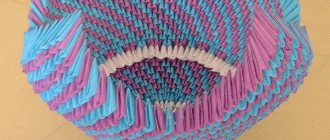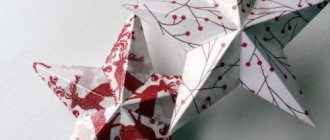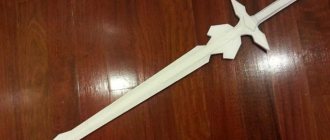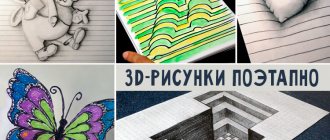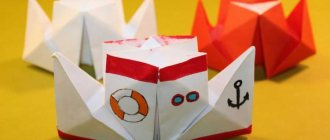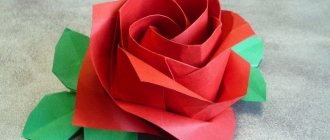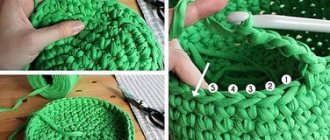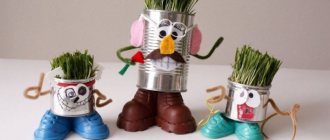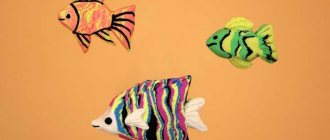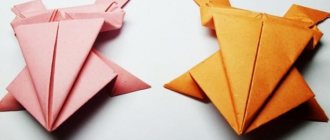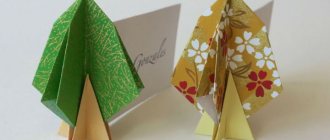Making any origami parrot is not difficult; it’s more difficult not to get lost in the variety of models. Particularly popular are long-tailed macaws, which can be placed on an arm, a cabinet door, or the back of a chair. In the east, parrots symbolize good luck and prosperity; their paired images are given to lovers “for good luck.” Colorful paper birds are a great way to decorate a tropical themed baby shower or party.
What will we need for this?
Before starting any work, you need to make sure that the work surface of the table is clean and ready for work. In addition, it wouldn’t hurt to give your child a short briefing on the safety of working with scissors and other materials.
It is better to help the little ones at all stages of work.
Origami is a very ancient art that was learned in China and Japan. It teaches the master self-control, patience, and allows him to develop his imagination and do incredible things with just one sheet of paper. For children, we have selected the most optimal basic schemes that even the smallest ones can do.
Budgie
Small colorful parrots are endemic to Australia and are recognized as the most popular pet birds. Today, there are much fewer of them left in the wild than are bred in captivity. Cheerful, easy-going disposition, beauty and sociability allow birds to easily win human hearts. Despite their small size, budgerigars are highly intelligent: they are able to remember more than 100 words, although they do not consciously reproduce speech. But they respond well to training and are happy to repeat the tricks suggested by the owner.
The origami parrot model is no less charming than the natural original. For it, they try to use paper with an oriental flavor - painted using the ombre technique or patterned. This option is universal and suitable for any decor.
An easier to read diagram of an origami budgerigar:
Step-by-step instruction:
You will need a square of paper with sides of different colors. The optimal size is 15x15 or 10x10 cm. We start working from the inside out.
- We outline one of the diagonals.
- Fold the right and left edges to it.
- We bend the upper triangle back.
- We fold the right and left corners to the central axis.
- You should get a figure like this.
- We open the resulting “pockets”.
- Raise both corners up along the dotted lines.
- We bend the lower part with a zigzag.
- Fold the figure in half into a “mountain”.
- Rotate 90° counterclockwise.
- Using a reverse fold, we tilt the top at a right angle. It turns out to be the head of a parrot.
Now the colorful origami figurine is ready to turn into a topper, table decoration or scrapbook decor. It will harmoniously combine with any other origami bird models.
The figurine is also suitable as jewelry:
Types of origami paper crafts
Origami refers to the art of folding a sheet of paper by bending without secondary cuts and joining by gluing or fixing with additional materials.
Simply put, paper art allows you to create a full-fledged three-dimensional figurine from paper, in which, without additional processing and decoration, the image that the creator put into it will be recognizable.
These same topics include art such as appliqué and modular origami, which we will discuss below.
Story
The origami style has a very rich history. There are many versions of the origin of this creative movement. It originated mainly in Asian countries.
Japan and China made the greatest contribution to the development of origami. At the time when the Heian period was emerging, figures made by Japanese masters in the origami style were presented at various Japanese aristocratic evenings.
It was popular among samurai who exchanged these figurines. Some took them with them for good luck, others gave them to friends as gifts. In Japan, this was taken very seriously; origami was not considered some kind of entertainment for children.
Later, in Europe they also began to learn about this type of needlework. Germany became the European pioneer of origami outside of Asia.
Europeans did not completely copy all aspects of Japanese origami. We only took the base.
German masters began to come up with their own style, which was different from what they did in Japan. By the middle of the 16th century, almost all advanced European powers learned about such an art form as origami.
Application on the theme of origami parrot
For this fake, it is enough to use a regular A4 sheet and a set of colored paper. For a child, you can make a paper blank in the shape of a bird.
After this, the young child covers the bird with pieces of torn paper of different colors. You can use the brightest colors, since these representatives of the bird family, as a rule, are full of elaborate colors in their plumage.
In addition, you can make a simple applique. It is enough to trace the outline of the bird, and then the child himself will start laying out the mosaic and gluing pieces of paper.
Interesting Facts
In the east, parrots have been revered since ancient times for their wisdom and magnificent attire. The ability of these birds to imitate human speech made them attractive conversationalists. The aristocrats of China kept parrots in their chambers and entrusted their most intimate secrets, believing that the winged listener would not tell anyone what he heard. In India, parrots were considered the liaison between earth and sky, since they could convey requests to the gods in human language.
These birds still surprise today:
- All species of parrots have a developed ear for music and are able to dance gracefully.
- Cockatoos and Grays live up to 70 years in domestic conditions.
- Almost all parrots are monogamous. Many species require a mate to feel comfortable in captivity. Birds become no less strongly attached to their owner if he is affectionate and attentive to them.
- Parrots do not have vocal cords; they produce all sounds using their beak and tongue.
- The largest species is the hyacinth macaw, reaching the size of a three-year-old child. Its length with tail is 1 m and its weight is 1.5 – 2 kg.
- Grays are considered smarter than others. The vocabulary of these parrots is up to 2000 words, and they use them appropriately, creating the impression of a meaningful conversation. In addition, Grays perfectly copy a person’s intonations and the emotions they express.
- Parrots “look around” 180°, second only to owls and eagle owls in this ability. The latter freely turn their heads 270°, thanks to the special structure of the neck vessels.
- Endemic to New Zealand, the owl parrot (kakapo) cannot fly due to its disproportionate weight. Evolution did not affect these birds, which were in natural isolation, so today they are considered living fossils. An amazing feature of kakapo is their smell, reminiscent of a cross between honey and flowers. It's as if birds wear expensive perfume every day.
- Parent parrots give their chicks “names” that are a set of individual sounds.
- Not all parrots eat fruits and greens. The kea species, native to New Zealand, prefers game and small livestock. Local farmers complain that winged robbers are stealing their sheep, causing damage to their flocks. However, in reality this is extremely rare by chance, since the relatively small kea prefer carrion.
A simple base shape for creating a parrot
For older children, we suggest plunging into the diverse world of origami, but let's start with a simple basic diagram, as a result of which we will get an original bird. First, let's make a basic "horn" shape. To do this, we turn the square in front of us in the form of a rhombus. We bend the edges symmetrically along the center line to form a “horn” that resembles an ice cream cone.
Next, we turn the top of the resulting triangle back to the fold line. We turn the two side wings of the pocket towards the middle. The turned away corners will be the parrot's future legs, and the resulting sharp tip will be the bird's tail. We form the head from the turned-down corner and make a beak from its edge. That's all! Now all that remains is to bend the structure in half and the parrot is ready. Add eyes or decorate the bird to your taste.
Simpler craft options
There are many ways to make paper crafts. For those who do not know origami techniques, but definitely want to make a paper parrot, we can recommend other techniques for the job. Each of them is simple and beautiful in its own way. In any case, the parrot will have an expressive beak and a bushy tail. Here's how to make a funny figurine:
- Use a ready-made 3D toy diagram. Such schemes are often published in children's magazines, for example, in the periodical “Paper Zoo”. To do this, you need to cut out a page with the diagram, stick it on cardboard, then cut out the development, fold it along the fold lines and glue it in the marked places. The main advantage of this option is that children's magazines publish color schemes, and the bird will turn out bright and elegant. Also, such a toy is stable and will last a long time, even if the child actively plays with it.
- You can make a parrot using the technique of ejection, or openwork cutting. To do this, you need to download diagrams from the Internet, cut out the drawing along the contour and cut holes in it in accordance with the diagram. The toy will be flat, two-dimensional, and perfect for interior decoration. You can cut such parrots from white, colored or even black paper. You can make several figures at once and hang them on a bright thread as a decorative garland.
- Another interesting option is a postcard with a three-dimensional image of a parrot using the kirigami technique (volume cutting). To do this, the sheet is folded in half in accordance with the diagram. Next, the design is cut out and folded along the marked lines. As a result, when the postcard is opened, a three-dimensional image of a bird appears. The simplest versions of kirigami are also published in children's magazines, and diagrams can also be found on the Internet.
For younger children, the first option is better. Vytynanka and kirigami require a higher level of skill with scissors, so crafts using this technique should only be performed by school-age children under adult supervision. In addition, for kirigami you will need a knitting needle to press the pattern along the fold lines. A DIY paper parrot will be an excellent gift for a birthday or any other occasion.
Scheme of a blue macaw parrot from modular origami
The first step of modular origami is to make a basic “socket”, which will consist of 6 purple and 5 turquoise modules. The order does not change, and rows 3 to 5 are assembled as standard. Further, starting from the 6th module, you determine the direction of the parrot “front” and “back”. Considering that this design is more complex, it is better to stick to the diagram. Beginning creators can make modules without color so that they can color their parrot later.
Next, for manufacturing, we add modules up to the 8th row. After that, add 2 turquoise modules to get a combination of 6 turquoise, 2 purple. For the front side we use 9 purple ones. The next row is the fastening row in the structure, which connects the front and back parts. We follow the order of adding on the stomach and back so as not to disturb the proportion of the picture.
On the 16th row you fix the red triangles for the bird's head. The next row will consist of a combination of 6 red ones, and the 18th row of 5 red ones, the 19th row is one module less (4). To assemble the bird's tail, you can use alternating rows or mix them in a checkerboard pattern.
That's all! At first glance, modular origami seems complicated, but once you practice the basics, everything will be simple! This way you can decorate various interior details. For example, a bird in the kitchen, a bookmark in a book, a postcard or a stand.
The attractive thing is that there are no restrictions in such a topic, and thanks to the variety of modular origami, you can, if necessary, disassemble the craft and use the modules on another one, just as you can do with a Lego constructor.
Tags
use paper square of paper from paper from paper from paper by your own from paper from paper from paper by your own sheet of paper size paper density 80 The ABC of origami or Origami for Origami from Origami techniques Origami tales in the east parrots symbolize the parrot family. A giant parrot is easy to make anyone How to make origami How to make your own How to make a Parrot How to make a parrot How to make a parrot How make a MonkeyHow to make a FoxHow to make a BunnyHow to make a Boat
parrotpaper handsrowssidesphotodetailscraftsnextclasseslinemebackthenbeautifulmiscellaneousblankwingsafterimageelementusephotosblankchildrenoptiontipcardboardwill
